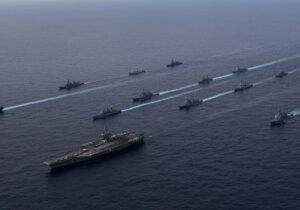From the moment Hamas launched its barbaric assault on Israel on October 7th, Israel’s normalization with Arab states, critics allege, was on the rocks and the prospects of the ultimate prize, Saudi-Israel normalization, was dead on arrival. Arab states, including the four that had made peace with Israel as part of the Abraham Accords in 2020, would have to choose between associating with a belligerent (and weak) Israel or appeasing an “Arab street”, inflamed by the images of death and destruction in Gaza and fomented by Iran and the Muslim Brotherhood to undermine the regimes from within. A weak and distracted Israel combined with an incited Arab street would cause the Arab monarchies to tilt towards Tehran, or at least away from Israel. Israel would have to choose between prosecuting the war or salvaging its regional realignment efforts. New York Times columnist and perennial Israel-skeptic Tom Friedman expressed this pithily in last week’s column: “Israel Has a Choice to Make: Rafah or Riyadh”.
But a funny thing happened on the way to appeasement: a joint US-Israeli-European-Arab coalition united to thwart the first direct Iranian air assault on Israel in history. Iran launched a barrage of over 300 missiles and suicide drones targeting Israel on the night of April 13th. Only a handful made impact, causing no casualties and little damage.
The coalition intercepted those that did not malfunction, mostly over the skies of Saudi Arabia, Iraq, Syria, and Jordan. America’s Arab allies had, in various ways, provided intelligence and allowed U.S. and Israeli planes to operate in their airspace. Jordan, which has been vociferously attacking Israel’s conduct in Gaza for months, even publicly acknowledged that it shot down incoming Iranian projectiles. When the chips were down, the Arab coalition held and made clear where they stood in the broader Iranian war on Israel.
For that, Biden owes much to his predecessor. This month’s successful wartime cooperation was years in the making. The 2020 Abraham Accords, particularly the treaties signed between Israel and the United Arab Emirates and Bahrain, allowed intelligence and military cooperation to surface and expand from its previously subterranean existence. The Trump Administration also initiated the realignment of Israel out of the U.S. European Command and into U.S. Central Command’s area of responsibility, which became official in 2021. A vestige of the days of U.S. acquiescence to the Arab boycott of Israel, this seemingly small U.S. bureaucratic change paid huge dividends as the U.S. was able to share intelligence, provide early warning, and coordinate interception. The air defense alliance aced its first test, tactically, operationally, and strategically.
The successful batting away of the Iranian air assault also engendered awe in Israel’s air defense capabilities, which have performed marvelously throughout the war. Operational for over a decade, Iron Dome, the lowest tier in Israel’s multi-layered missile defense network, has saved tens of thousands of Israeli lives in this war alone. David’s Sling, the middle tier jointly developed with the United States, made its first interception a year ago, and has intercepted several dozen missiles since the war began. Finally, the Arrow 3, the upper tier system also jointly developed with the U.S., made its successful debut during this war, intercepting a Houthi-launched ballistic missile in November and an Iranian one in April in the exo-atmosphere. Iron Dome is deployed by the U.S. Army and Israel has concluded deals to sell David’s Sling to Finland and Arrow 3 to Germany. As Saudi Arabia, the UAE, Jordan, and other Arab states continue to face the proliferation of the Iranian missile threat, they too will become beneficiaries of, if not customers for, Israel’s military technological prowess.
Israel’s response to the Iranian night of missiles should give further courage to Saudi Arabia to codify its alignment. Israel opted for a very limited response: a single missile that destroyed an Iranian anti-aircraft system in Natanz, a known key nuclear site, all reportedly without Israeli jets entering Iranian airspace. Yet, in doing so, it telegraphed clearly to Tehran that it could hit precise targets without its aircraft being endangered and that the threshold of a direct Israeli strike on Iranian nuclear or other sites had been breached. The entire episode demonstrated that Israel can both hit Iranian sites and defend against an Iranian response. At a time when the United States is focused on de-escalation and restraint, Riyadh could see quite clearly that only Israel has both the capability and the will to deal with the Iranian threat.
It is impossible to know whether the renewed U.S.-Saudi-Israel negotiations will lead to a normalization deal in the immediate months ahead. The Biden Administration is demanding that Israel commit to a “concrete, time-bound, irreversible path to a Palestinian state”, whereas the Israeli public is aghast at the idea of having Gaza redux in Judea and Samaria (the West Bank) after October 7th. It also is unclear if an unpopular, weak, and reelection-focus President Biden can deliver on both the nuclear enrichment and security assurances Saudi Arabia is demanding from the United States. Regardless of the status of this deal or how difficult the war in Gaza may appear, America’s Arab allies have now become Israel’s.






